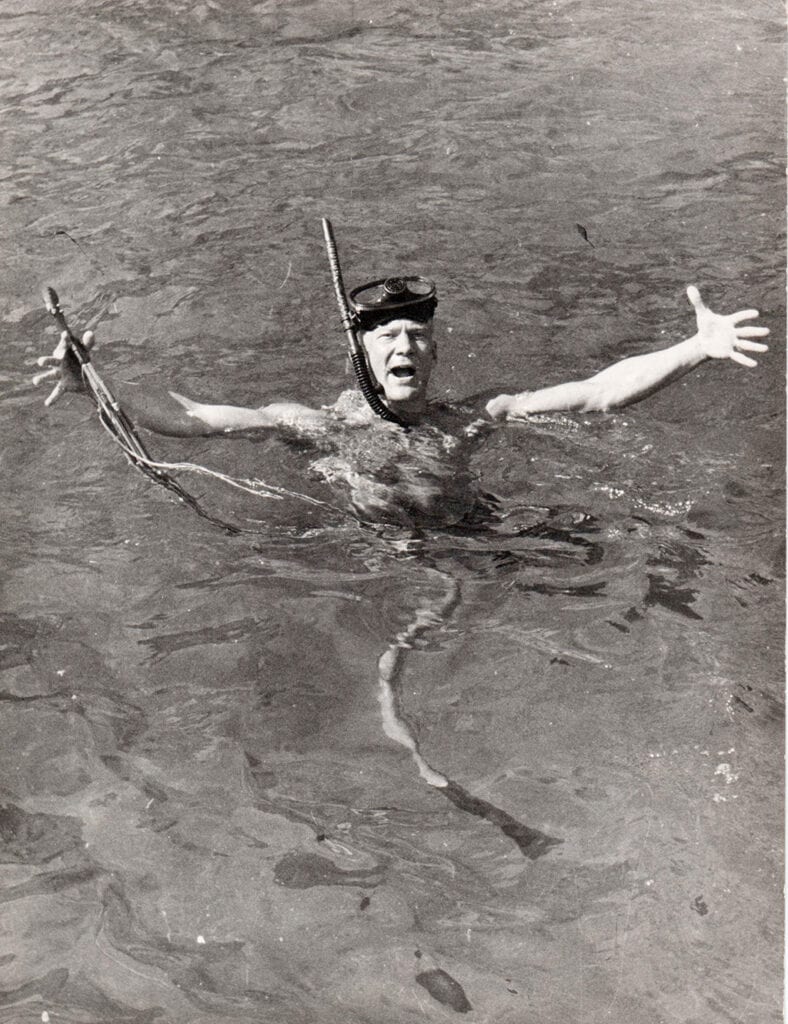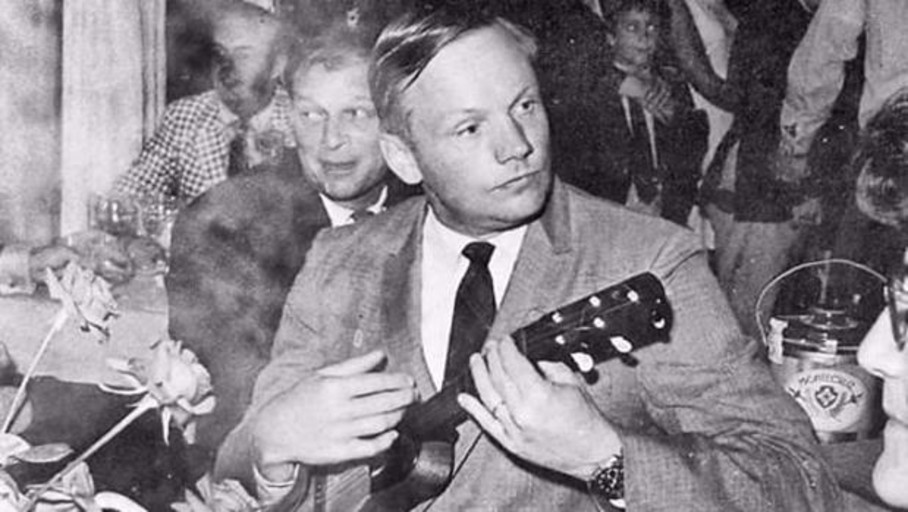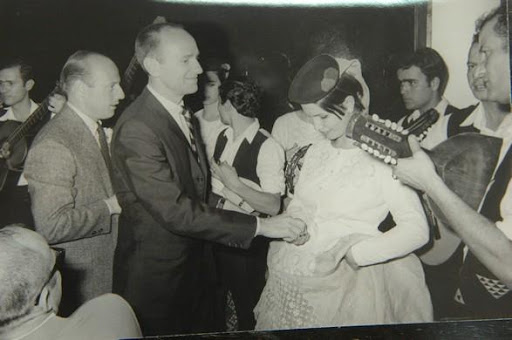El Austin usado por Los Beatles en 1963 en el Puerto de la Cruz, Tenerife, fue comprado veinte años después por un empresario tinerfeño.................The Austin used by The Beatles in 1963 in Puerto de la Cruz, Tenerife, was bought twenty years later by a Tenerife businessman.

1.- LOS BEATLES EN TENERIFE
En 1960 los Beatles eran muy poco conocidos y una de sus primeras salidas de Inglaterra fue a Hamburgo actuando en una sala de espectáculos propiedad de un alemán llamado Klaus Voormann. Los Beatles eran cinco todavía y aun no estaba Ringo Starr que llego un año después.
En 1963, cuando terminaron de grabar su primer álbum “Please, please me”, se tomaron diez días de vacaciones. John Lennon se fue a Torremolinos y Paul MacCartney, George Harrison y Ringo Starr aceptaron la invitación de Klaus Voorman para pasar esos días en la casa que sus padres tenían en los Realejos en Tenerife.
El 29 de abril de 1963 llegaron a Tenerife y se movieron por todo el norte con un Austin Healey matrícula GG 14112, que casi siempre conducía George Harrison, y un Singer alquilado.
Eran tan poco conocidos que cuentan que el gerente de las piscinas del Lido no les permitió actuar “porque su música no se entendía en Tenerife”.
Poco después se convirtieron en el grupo musical mas famoso de la historia,
En un artículo de NORBERTO CHIJEB en Diario de Avisos de junio de 2020 se contó que hace unos treinta años un empresario de Santa Cruz de Tenerife vio aquel Austin en muy mal estado en algún lugar de los Realejos, y le gusto tanto que no paró hasta dar con su propietario, Klaus Voorman, comprar el coche y mantenerlo hasta hoy en su colección de coches antiguos. Asi que amigos de Tenerife, si ven alguna vez ese Austin matricula GG 14112, de un color rojo precioso, estarán viendo el coche que usaron los Beatles.
Desde Google poniendo los Beatles en Tenerife 1963 encontraran un montón de fotos muy interesantes de esta increíble visita.
ç
ENGLISH
In 1960 the Beatles were little known and one of their first outings out of England was to Hamburg performing in a showroom owned by a German named Klaus Voormann. The Beatles were still five and there was still no Ringo Starr who arrived a year later.
In 1963, when they finished recording their first album «Please, please me», they took a ten-day holiday. John Lennon went to Torremolinos and Paul MacCartney, George Harrison and Ringo Starr accepted Klaus Voorman’s invitation to spend those days at his parents’ house in Los Realejos in Tenerife.
On 29 April 1963 they arrived in Tenerife and moved around the north of the island in an Austin Healey, registration number GG 14112, which George Harrison almost always drove, and a rented Singer.
They were so little known that it is said that the manager of the Lido swimming pools would not allow them to perform «because their music was not understood in Tenerife».
Shortly afterwards they became the most famous musical group in history,
In an article by NORBERTO CHIJEB in Diario de Avisos in June 2020 it was told that about thirty years ago a businessman from Santa Cruz de Tenerife saw that Austin in very bad condition somewhere in Los Realejos, and he liked it so much that he didn’t stop until he found its owner, Klaus Voorman, bought the car and kept it until today in his collection of old cars. So friends from Tenerife, if you ever see that Austin, registration number GG 14112, in a beautiful red colour, you will be looking at the car that the Beatles used.
From Google by putting the Beatles in Tenerife 1963 you will find a lot of very interesting pictures of this incredible visit.
Translated with www.DeepL.com/Translator (free version)
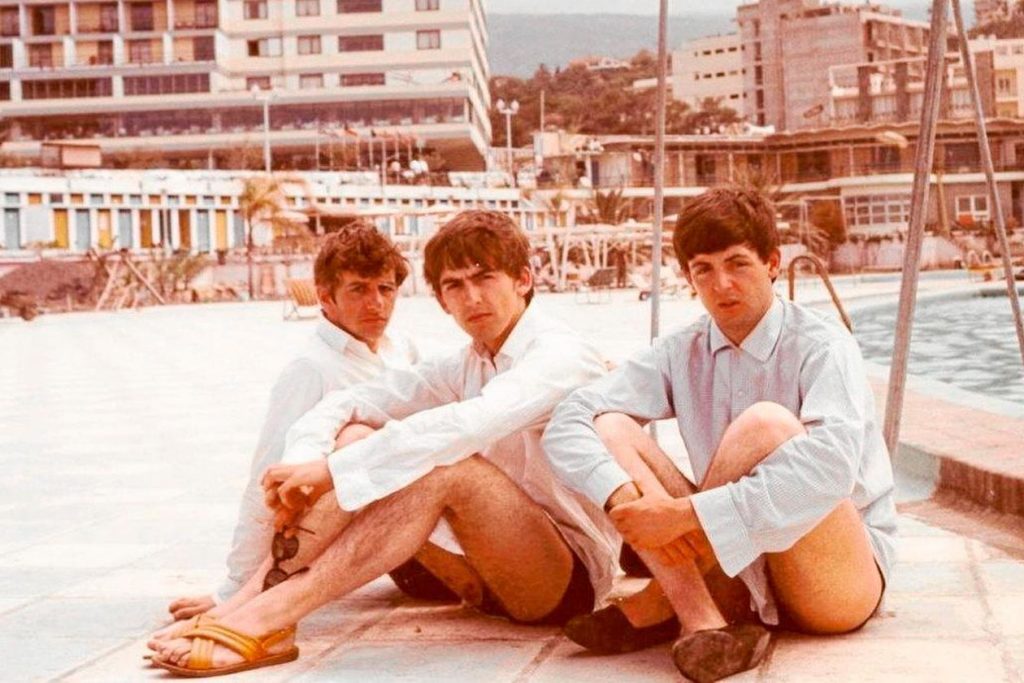

2.- FLOR DE CADA 30 AÑOS, Jardín Botánico Puerto de la Cruz
En Tenerife tenemos el Jardín Botánico en el Puerto de la Cruz, que fue construido a finales del siglo XVIII, por orden del Rey Carlos III. A día de hoy cuenta con una superficie de más de 20.000 m² de pura belleza, con una enorme muestra de plantas tropicales entre las que se encuentra una que florece cada 30 años.
La Agave Cacozela es una Agave Caribeña que está formada por numerosas flores doradas, distribuidas de forma muy compacta en una gran vara que puede llegar a los siete metros de altura.
Florece una vez cada 30 años y cuando florece muere. El esfuerzo de crecer en una vara tan alta hace que la flor muera al poco tiempo, pero deja semillas que se conservan para que vuelvan a florecer dentro de otros treinta años.
ENGLISH
In Tenerife we have the Botanical Garden in Puerto de la Cruz, which was built at the end of the 18th century, by order of King Carlos III. Today it covers an area of more than 20,000 m² of pure beauty, with a huge display of tropical plants, including one that flowers every 30 years.
The Agave Cacozela is a Caribbean Agave that is made up of numerous golden flowers, distributed in a very compact form on a large cane that can reach up to seven metres in height.
It flowers once every 30 years and when it flowers it dies. The effort of growing on such a tall cane causes the flower to die soon after, but it leaves seeds that are preserved to flower again in another thirty years.
Translated with www.DeepL.com/Translator (free version)

3.- SALMON AHUMADO DE UGA, Lanzarote
En uno de los pueblos más bonitos de Canarias, Uga (Yaiza), en Lanzarote, se hace un exquisito salmón ahumado que pasa por ser uno de los mejores del mundo.
Actualmente la Ahumadería de Uga está dirigida por Paloma Guerrero Suárez que es la segunda generación de la familia. Hace treinta años, poco antes de nacer Paloma, sus padres compraron los hornos a una pareja alemana y también las recetas que usaban para el ahumadero.
Compran salmones escoceses y noruegos de calidad, que llegan eviscerados y congelados, por aquello del anisakis y los protocolos sanitarios. Una vez descongelado y limpio, se le reviste 24 horas con un traje de sal de las cercanas playas de Janubio, en Yaiza. El horno se alimenta con sarmientos de La Geria y un cóctel de maderas. Tras 36 horas, a sólo 10º C, como si se tratara de un perfumado baño turco, el salmón ya está listo. Esta receta original es el gran secreto de la familia.
Lanzarote es la unión del arte y la belleza con la naturaleza, un lugar volcánico único en el mundo maravillosamente bien adaptado a las visitas por el gran artista lanzaroteño Cesar Manrique. Una visita imprescindible al menos una vez en la vida. Y una de las maravillas que tiene es la delicia gastronómica del salmón ahumado en esos hornos de Uga. Una delicatesen apreciada por los grandes gourmets del todo el mundo.
ENGLISH
In one of the most beautiful villages of the Canary Islands, Uga (Yaiza), in Lanzarote, an exquisite smoked salmon is made which is considered to be one of the best in the world.
Today the Ahumadería de Uga is run by Paloma Guerrero Suárez who is the second generation of the family. Thirty years ago, shortly before Paloma was born, her parents bought the ovens from a German couple and also the recipes they used for the smokehouse.
They buy quality Scottish and Norwegian salmon, which arrive gutted and frozen, because of anisakis and health protocols. Once thawed and cleaned, it is coated for 24 hours with a salt suit from the nearby beaches of Janubio, in Yaiza. The oven is fed with vine shoots from La Geria and a cocktail of woods. After 36 hours, at only 10º C, as if it were a perfumed Turkish bath, the salmon is ready. This original recipe is the great family secret.
Lanzarote is the union of art and beauty with nature, a unique volcanic place in the world, wonderfully well adapted for visits by the great Lanzarote artist Cesar Manrique. An essential visit at least once in a lifetime. And one of its wonders is the gastronomic delight of salmon smoked in the ovens of Uga. A delicacy appreciated by gourmets from all over the world.
Translated with www.DeepL.com/Translator (free version)
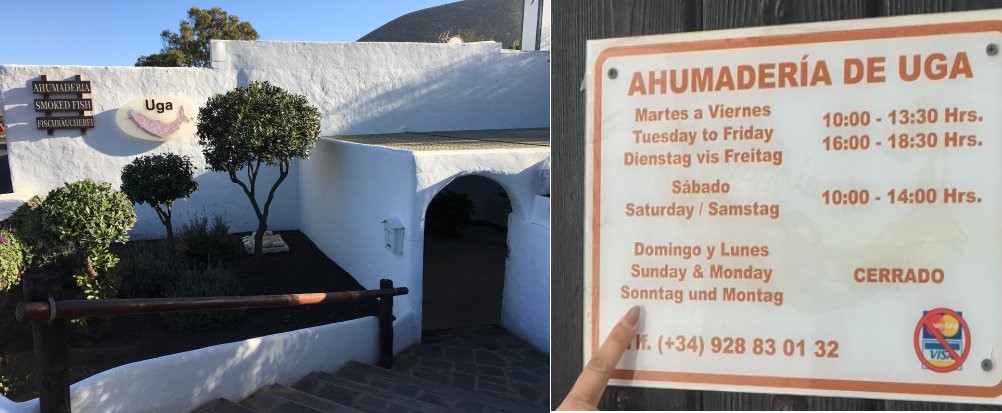
4.- CEMENTERIOS INGLESES EN CANARIAS,
Hay tres Cementerios ingleses en Canarias, uno en Las Palmas de Gran Canaria construido en 1834, otro en Santa Cruz de Tenerife dentro del Cementerio Católico de San Rafael y de San Roque con un primer enterramiento en 1837 y el más antiguo, el del Puerto de la Cruz, construido en 1747, debido a los ingleses que se establecieron en la Orotava y en el Puerto de la Cruz para exportar el vino que se producía en la isla.
El Cementerio en nuestra ciudad esta en el barrio de San José, y se construyó en 1830 porque al fallecer la esposa de Benjamín Walter fue denegada la solicitud de enterrar su cuerpo en el Cementerio Católico de la ciudad de Las Palmas de Gran Canaria por lo que el 9 de febrero de 1829 fue enterrada, de acuerdo con los ritos protestantes, en los extramuros de la propia ciudad. En consecuencia, a principios de 1830, algunos residentes británicos junto al Vicecónsul decidieron adquirir un terreno para destinarlo a cementerio, propiedad a la que contribuyó el Gobierno de S.M. británica con 50 libras con la condición de que los residentes en la isla pusieran una cantidad igual. Según la documentación obrante en el expediente, finalmente el terreno fue cedido por el Ayuntamiento de Las Palmas de Gran Canaria.
Entre los promotores del mismo estaban George y James Swanston, Thomas Miller y el Vicecónsul británico George Anstice . Entre todos ellos aportaron 308 pesos equivalentes a las 50 libras esterlinas que debían poner para cumplir con el acuerdo con el Gobierno de su país. Los promotores se reservaron enterramientos para sus familias como manera de comensar la fuerte inversión que tenían que realizar.
ENGLISH
There are three English Cemeteries in the Canary Islands, one in Las Palmas de Gran Canaria built in 1834, another in Santa Cruz de Tenerife within the Catholic Cemetery of San Rafael and San Roque with a first burial in 1837 and the oldest, the one in Puerto de la Cruz, built in 1747, due to the English who settled in La Orotava and Puerto de la Cruz to export the wine produced on the island.
The Cemetery in our city is in the district of San José, and was built in 1830 because when Benjamin Walter’s wife died, her request to bury her body in the Catholic Cemetery of the city of Las Palmas de Gran Canaria was denied, so on the 9th of February 1829 she was buried, according to Protestant rites, outside the walls of the city itself. Consequently, at the beginning of 1830, some British residents together with the Vice-Consul decided to acquire a plot of land to be used as a cemetery, a property to which the British Government contributed 50 pounds on the condition that the residents of the island would contribute an equal amount. According to the documentation on file, the land was finally ceded by the Town Council of Las Palmas de Gran Canaria.
Among the promoters were George and James Swanston, Thomas Miller and the British Vice Consul George Anstice. Between them they contributed 308 pesos equivalent to the 50 pounds sterling they had to put up to comply with the agreement with the British Government. The promoters reserved burials for their families as a way of offsetting the heavy investment they had to make.
Cementerio Inglés, barrio de San José, Las Palmas de Gran Canaria
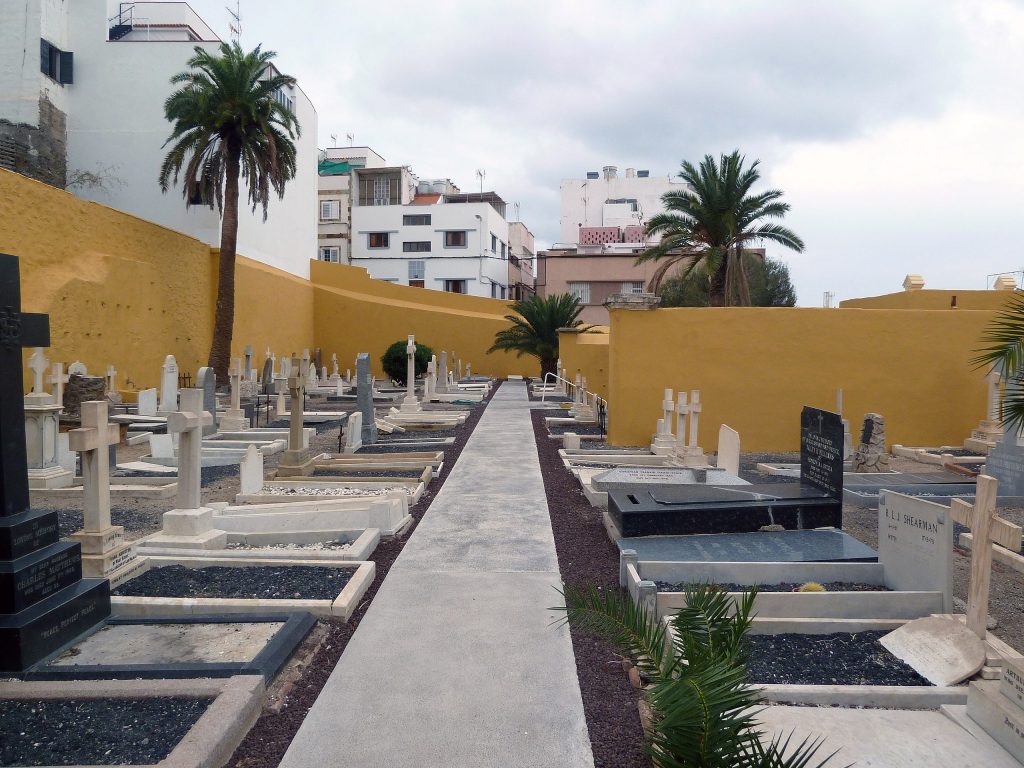
5.- ARMSTRON, ALDRIN Y COLLINS DESDE LA LUNA A GRAN CANARIA, 1969
El 20 de julio de 1969 Armstron y Aldrin pisaron la Luna por primera vez mientras Collins permanecía en el módulo de mando del Apolo XI para asegurar el regreso de los tres a la tierra. El 24 de julio amerizaron en el Pacífico y comenzaron una cuarentena de seguridad.
Del 29 de septiembre al 5 de noviembre realizaron un viaje por todo el mundo, con sus esposas, en el Air Force One. Y del 4 al 6 octubre estuvieron en Gran Canaria, hospedándose en el Hotel Oasis Maspalomas. Esta visita fue la más importante publicidad para nuestra isla y para Maspalomas, que iniciaba el viaje del turismo internacional que le ha convertido en la primera industria de Canarias.
Una de las fotos más celebres de este viaje muestra a Buzz Aldrin en el agua con sus gafas de buceo y abriendo los brazos con una expresión de asombro. El astronauta hablaba de una gran rueda de tractor que había visto en el fondo, pero los periódicos de todo el mundo la publicaron como que Aldrin había visto un mero enorme en aguas de Canarias. Evidentemente esta confusión dio una promoción descomunal al archipiélago.
Todo esto fue posible por la importancia de la Estación Espacial de Maspalomas, que era la encargada de establecer contacto con los tripulantes de la cápsula Apolo XI y de grabar todo lo que hablasen los Astronautas durante su viaje.
ENGLISH
On 20 July 1969 Armstron and Aldrin set foot on the Moon for the first time while Collins remained in the Apollo XI command module to ensure the return of the three to Earth. On 24 July they splashed down in the Pacific and began a safety quarantine.
From 29 September to 5 November they made a trip around the world, with their wives, on Air Force One. And from 4 to 6 October they were in Gran Canaria, staying at the Hotel Oasis Maspalomas. This visit was the most important publicity for our island and for Maspalomas, which started the journey of international tourism that has turned it into the first industry of the Canary Islands.
One of the most famous photos of this trip shows Buzz Aldrin in the water wearing his diving goggles and opening his arms with an expression of astonishment. The astronaut was talking about a large tractor wheel he had seen on the bottom, but newspapers around the world reported it as Aldrin seeing a huge grouper in the waters off the Canary Islands. Evidently this confusion gave the archipelago a huge promotion.
All this was made possible by the importance of the Maspalomas Space Station, which was in charge of establishing contact with the crew of the Apollo XI capsule and recording everything the Astronauts said during their journey.
La famoso foto de Buzz Aldrin con el "mero"......The famous photo of Buzz Aldrin with the "grouper" ......
